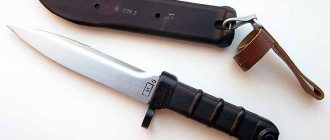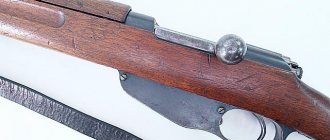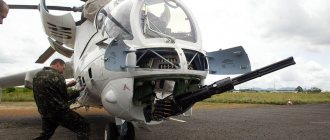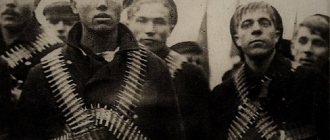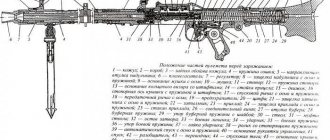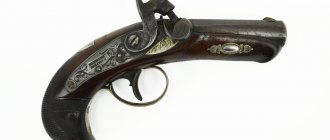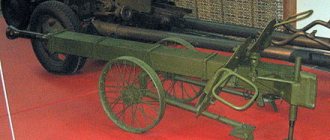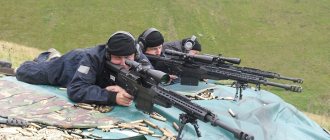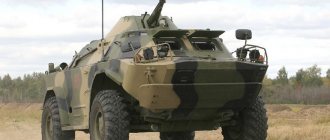Bayonet for the Chassepot rifle model 1866 France
Model 1866 bayonet for a Chassepot rifle. In excellent collectible condition. The bayonet-knife itself was released in 1874, as evidenced by the inscription on the butt of the scimitar-type blade. The heel of the blade bears the manufacturer's inspection marks. Shipping within the Russian Federation is possible. Technical description: The blade of the bayonet is of the scimitar type, single-edged, with a fuller on both sides. The fighting end is double-edged. The handle is brass, with transverse grooves. In the back of the handle there is a longitudinal groove along the entire length. The head of the handle has a T-shaped groove and a spring latch with an external leaf spring. A cross with a forward-curved end ending in a ball and with a ring for the barrel on the butt side of the blade. The legs of the cross, forming a ring, are fastened with a screw. Steel scabbard with a bracket and a ball at the end. In the case of French-made bayonets, the name of the manufacturer as well as the year and month of manufacture of the blade (not the bayonet) are engraved on the back of the blade. Since during the period of production of bayonets of this model, France lived a rather stormy domestic political life - in less than 10 years, four formats of these inscriptions changed depending on the government. 1) From the moment the production of bayonets began until October-November 1870 (the end of the second Empire), the inscription on the back of the blade was written in italics according to the following pattern: “Imperial Factory (name), month and year of production.” 2) From the time of the overthrow of Napoleon III until 1871, during the reign of the provisional government of national defense, the first part of the inscription changed to “National Factory”. 3) After 1871 and before the beginning of 1873, only the name of the plant, month and year were engraved. 4) After 1873, "arms manufacturer (name), month and year." There are many exceptions to this system that appeared during the Franco-Prussian War. Bayonets were then produced not only by state arsenals, but also by private enterprises, and were also supplied from abroad and were not marked according to the established pattern, often to hide their source. In addition to France, bayonets were produced in Germany, Belgium, Great Britain and other countries, both for export to France during the war and for sale to other countries to which Chassepot rifles were supplied. On the heel of the blade there are inspection and production management stamps on the right side and metal batch numbers on the left; acceptance stamps are also located on the bayonet cross. On the crosspiece of the bayonet and on the scabbard near the mouth is the rifle number, consisting of a letter and numbers. The bayonet was adjusted to the rifle individually, that is, it often could not be used with someone other than “your” rifle. What was the subject of criticism of the Chassepot system. The capital letter before the number indicated the arsenal. The meaning of the letters X and Z was slightly different. X - bayonets produced in Paris during the siege of 1870 - 1871 and bayonets for artillery blunderbusses and carbines of the foot gendarmerie model 1874. The bayonets produced during the siege also lack most of the inspection stamps. Z – bayonets issued without rifles. Occasionally, on the crosshairs and scabbard you can find a mark in the form of an anchor, this means that the bayonet was in service with the navy or colonial troops. During the war of 1870-71, Germany captured a huge number of rifles and bayonets, some of them were sold to third countries. And some of the bayonets were altered (the bracket on the scabbard was changed to a hook and German acceptance stamps were placed) and were used in the German army as a cleaver. Later the bayonet was modified for attachment to rifles of other models. Total length: 700 mm Blade length: 580 mm Blade width: 30 mm Internal diameter of the cross ring: 17.5 mm
Chassepot rifle
In France, in 1866, a 4.3-line rifle was adopted, the bolt of which, developed by Lieutenant Chassepot, was better than that of Draize in terms of obturation, thanks to the rubber circles under the cap of the fungus inserted in front of the bolt, as well as the shortening of the needle, as a result of which it broke down less often; the shortening of the needle was achieved by placing the primer in the folder bottom of the sleeve; the compression system bullet cut itself into the rifling, so there was no need for a bullet pin. The hammer was cocked not in two steps, as with Dreyse, but in one step when closing the bolt. Thanks to a good seal and a higher initial bullet speed (420 m/s instead of the then usual 300 m/s), the accuracy of the Chassepot gun was greater.
Excerpt characterizing the Needle Gun
They stood silently opposite each other. The old man's quick eyes were directly fixed on his son's eyes. Something trembled in the lower part of the old prince’s face. - Goodbye... go! - he suddenly said. - Go! - he shouted in an angry and loud voice, opening the office door. - What is it, what? - asked the princess and princess, seeing Prince Andrei and for a moment the figure of an old man in a white robe, without a wig and wearing old man’s glasses, leaning out for a moment, shouting in an angry voice. Prince Andrei sighed and did not answer. “Well,” he said, turning to his wife. And this “well” sounded like a cold mockery, as if he was saying: “Now do your tricks.” – Andre, deja! [Andrey, already!] - said the little princess, turning pale and looking at her husband with fear. He hugged her. She screamed and fell unconscious on his shoulder. He carefully moved away the shoulder on which she was lying, looked into her face and carefully sat her down on a chair. “Adieu, Marieie, [Goodbye, Masha,”] he said quietly to his sister, kissed her hand in hand and quickly walked out of the room. The princess was lying in a chair, M lle Burien was rubbing her temples. Princess Marya, supporting her daughter-in-law, with tear-stained beautiful eyes, still looked at the door through which Prince Andrei came out, and baptized him. From the office one could hear, like gunshots, the often repeated angry sounds of an old man blowing his nose. As soon as Prince Andrei left, the office door quickly opened and the stern figure of an old man in a white robe looked out. - Left? Well, good! - he said, looking angrily at the emotionless little princess, shook his head reproachfully and slammed the door. In October 1805, Russian troops occupied the villages and towns of the Archduchy of Austria, and more new regiments came from Russia and, burdening the residents with billeting, were stationed at the Braunau fortress. The main apartment of Commander-in-Chief Kutuzov was in Braunau. On October 11, 1805, one of the infantry regiments that had just arrived at Braunau, awaiting inspection by the commander-in-chief, stood half a mile from the city. Despite the non-Russian terrain and situation (orchards, stone fences, tiled roofs, mountains visible in the distance), despite the non-Russian people looking at the soldiers with curiosity, the regiment had exactly the same appearance as any Russian regiment had when preparing for a review somewhere in the middle of Russia. In the evening, on the last march, an order was received that the commander-in-chief would inspect the regiment on the march. Although the words of the order seemed unclear to the regimental commander, and the question arose how to understand the words of the order: in marching uniform or not? In the council of battalion commanders, it was decided to present the regiment in full dress uniform on the grounds that it is always better to bow than not to bow. And the soldiers, after a thirty-mile march, did not sleep a wink, they repaired and cleaned themselves all night; adjutants and company commanders counted and expelled; and by morning the regiment, instead of the sprawling, disorderly crowd that it had been the day before during the last march, represented an orderly mass of 2,000 people, each of whom knew his place, his job, and of whom, on each of them, every button and strap was in its place and sparkled with cleanliness . Not only was the outside in good order, but if the commander-in-chief had wanted to look under the uniforms, he would have seen an equally clean shirt on each one and in each knapsack he would have found the legal number of things, “sweat and soap,” as the soldiers say. There was only one circumstance about which no one could be calm. It was shoes. More than half the people's boots were broken. But this deficiency was not due to the fault of the regimental commander, since, despite repeated demands, the goods were not released to him from the Austrian department, and the regiment traveled a thousand miles. The regimental commander was an elderly, sanguine general with graying eyebrows and sideburns, thick-set and wider from chest to back than from one shoulder to the other. He was wearing a new, brand new uniform with wrinkled folds and thick golden epaulettes, which seemed to lift his fat shoulders upward rather than downwards. The regimental commander had the appearance of a man happily performing one of the most solemn affairs of life. He walked in front of the front and, as he walked, trembled at every step, slightly arching his back. It was clear that the regimental commander was admiring his regiment, happy with it, that all his mental strength was occupied only with the regiment; but, despite the fact that his trembling gait seemed to say that, in addition to military interests, the interests of social life and the female sex occupied a significant place in his soul. “Well, Father Mikhailo Mitrich,” he turned to one battalion commander (the battalion commander leaned forward smiling; it was clear that they were happy), “it was a lot of trouble this night.” However, it seems that nothing is wrong, the regiment is not bad... Eh? The battalion commander understood the funny irony and laughed. - And in Tsaritsyn Meadow they wouldn’t have driven you away from the field. - What? - said the commander. At this time, along the road from the city, along which the makhalnye were placed, two horsemen appeared. These were the adjutant and the Cossack riding behind. The adjutant was sent from the main headquarters to confirm to the regimental commander what was said unclearly in yesterday's order, namely, that the commander-in-chief wanted to see the regiment exactly in the position in which it was marching - in overcoats, in covers and without any preparations. A member of the Gofkriegsrat from Vienna arrived to Kutuzov the day before, with proposals and demands to join the army of Archduke Ferdinand and Mack as soon as possible, and Kutuzov, not considering this connection beneficial, among other evidence in favor of his opinion, intended to show the Austrian general that sad situation , in which troops came from Russia. For this purpose, he wanted to go out to meet the regiment, so the worse the situation of the regiment, the more pleasant it would be for the commander-in-chief. Although the adjutant did not know these details, he conveyed to the regimental commander the commander-in-chief’s indispensable requirement that the people wear overcoats and covers, and that otherwise the commander-in-chief would be dissatisfied. Having heard these words, the regimental commander lowered his head, silently raised his shoulders and spread his hands with a sanguine gesture. - We've done things! - he said. “I told you, Mikhailo Mitrich, that on a campaign, we wear greatcoats,” he turned reproachfully to the battalion commander. - Oh, my God! - he added and decisively stepped forward. - Gentlemen, company commanders! – he shouted in a voice familiar to the command. - Sergeants major!... Will they be here soon? - he turned to the arriving adjutant with an expression of respectful courtesy, apparently referring to the person about whom he was speaking.
Carle rifle
In 1868, the German Karle, who lived in Great Britain, received a patent for his own needle gun system, in general very similar to the Chassepot system. This system was used in Russia to convert a 6-line rifle into a breech-loading one. In the Karle shutter the needle was even shorter, and in the shutter the rubber mugs were replaced by leather ones. For his cartridge, Karle took the Minié bullet with a cup in the bottom, which was also used in Russian 6-line guns loaded from the muzzle and placed it more than half in a paper sleeve with a folder tray glued together from three circles, with an average smaller diameter, the capsule was pressed in; and near this mug, the sleeve is crimped on the outside and tied with woolen thread, which contributes to a better seal. When firing, the shutter needle had to pierce only the rear circle. Several hundred converted rifles successfully withstood combat tests in Turkestan. But due to the high cost of conversion and the difficulty of manufacturing cartridges, as well as the general shortcomings of paper cartridges, further conversion of guns according to the Karle system was suspended, and the remaining rifles were converted according to the Krnka system for a cartridge with a metal sleeve, proposed in 1868. Needle rifles in Russia were almost immediately replaced by the Berdan rifle No. 1 in 1868 (an episode of the “unhappy gun drama”).
